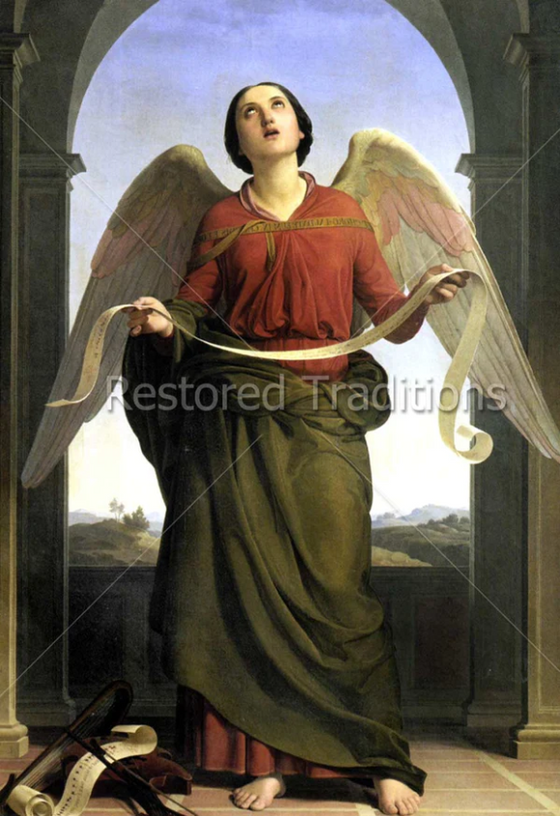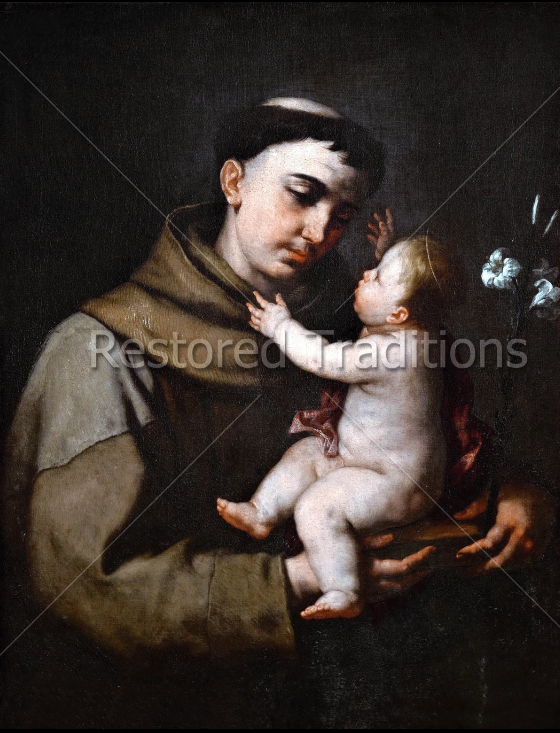While we enhance and restore religious images all day, we zoom in on an unprecedented amount of art. We stare at every pixel, fix every color and remove every blemish. One of the neatest things about our work, though, is picking up on trends that different artists employ.
We can't help but cracking up a bit by noticing Carl Bloch's sense of humor and simplicity. It's fun to get to know the personality of the artist through the greatest legacy he left behind. No, Bloch didn't write a nifty blog—he spoke through his paintings. It's fascinating to get to know a person solely through their art!
So what have we learned about our new friend Carl? He loved sneaking random children into his paintings that express some of the greatest stories of Catholicism. It's not something you notice right away, and it's not something he did in every painting, but there are certainly enough of his artworks where children show up (usually appearing around 10-years-old) and, what's even more cool is that they're usually the only ones looking right at the viewer's eyes, shoes or shoulders. Subliminal messaging you say? ha!
Carl Bloch had eight children whom he dearly loved. His friend, Hans Christian Andersen (famous children's author), also saw the simplicity of a child in Bloch's very personality. To commemorate one of his books, Andersen wrote the following verse about Carl Bloch:
"When we then met, you were just as I thought
A child in soul and yet so manly wise.
Modest, doubting of thy own strength
Yet very sure of what Our Lord had bade thee
For otherwise such work could never be done."

In one of Bloch's letters to Andersen, Carl expressed his desire to create art that inspires simple people.
"Should I have a desire here on the earth that I dare hope would be fulfilled, it would be that I might do things that the simple man (he who has been there all along) would esteem well."
So let's do a survey of some of these children that show up in his paintings. Perhaps the children were even modeled off his own children.
In Christ the Consolator, Christ outsretches his arms to embrace mankind. Jesus is surrounded by suffering souls who are looking all over the place, and we see the only person looking at the camera (ahem, viewer) is a child with a doubtful look on his face. It almost looks like a hand-caught-in-the-cookie jar look. But that's just our take.
The painting of Christ Cleansing the Temple shows a crop of terrified merchants running for their lives as Jesus gives them the boot from the temple. The frightened looking child is lost in the chaos of the moment while all are fleeing. He appears to have a rag over his arm, so maybe he's the sandal shiner boy, or perhaps a child of one of the merchants.
In Come Unto Me, it appears to be a little girl looking at the viewer this time around. So far, it appears to be a boy in all the other images. Once again, as in the case of Christ the Consolator, everyone is looking in different places and worrying about their troubles. Only the child stares at you with a slightly somber look as if to say: "it's ok, be simple like me and you'll get to heaven."
While Christ Heals the Blind Man on the road to Jericho, we get to see a variety of characters; once again with all different expressions and moods (read our blog post about these personalities). Though it's easy to infer a lot of different moods in this painting, one of the most obscure characters is the grinning child we see being held back by his dad. He's probably giggling, because it looks like his distracted brother is playing with his hair (parents, you know the drill). One can imagine the father whispering to his child: "Sshhh, son. Our Lord is tied up doing a miracle right now. We probably won't get a chance to see this again; you know how the people always crowd Him, and it's hard to get a good spot."
Once again, while Christ Heals the Paralytic at the Bethesda Pool, a sole and obscure child is one of two looking at the viewer. This time, the child is with his mother (lady holding the water pot) and possibly his grandma (directly above child) who, interestingly enough, is also staring at the viewer as well. The old woman behind the child is smiling this time, while the child has a dazed look on his face that's either oblivious to the miracle going on or still trying to figure out what's happening on their daily water run.
This time around, it's a little more difficult to spot our staring child in the painting Christ and the Children. The most obvious child in the detail above is intently looking at Jesus, while a tiny half face and eye (rest hidden in a shadow) appears to be looking at your shoes. Perhaps, in this case, he's simply waiting his turn to receive a blessing from Christ. Isn't that life? We spend half of it waiting in lines.
It's pretty hard to miss the child in Christ and the Small Child. Our Lord embraces and emphasizes the olive-branch holding boy who appears to be looking at your right shoulder this time around (coffee stain on your shirt maybe?). Certainly the emphasis on the child is that you need to be simple like him to gain the kingdom of heaven. The olive branch, on the other hand, traditionally symbolizes Christ's victory over death.
We almost missed this child while wading through Carl Bloch's art, but there the hidden boy is (almost as hidden as the one in Christ and the Children). While Jesus Christ is Raising Lazarus from the Dead (see a shadowed Lazarus ambulating out of the tomb?), we catch a glimpse once again of a shadowy face and single eye staring at your eye. It's hard to tell, but the boy looks a little frightened this time. It's not that surprising, considering the crowd has gathered at the local graveyard, which is probably not the place the boy usually goes to play. However, what's possibly more terrifying (and incredible) is to hear and see Lazarus walking out of the tomb after you probably saw him cold and dead at the wake a few days previous.
Once again, it's very difficult to miss the child in the painting where Jesus is Found in the Temple. This time, though, he's not looking at your shoes or eyes but at the Virgin Mary and St. Joseph. In this painting, Bloch wants us to focus and imagine the expressions of the two as they see their twelve-year-old son Jesus after searching Jerusalem for three days. Judging by the look on the boy's face, he appears to be sad, surprised and empathetic after seeing their joy and tears—something we can use for our meditations on this mystery of the life of Christ.
And, finally, one of our very favorites at Restored Traditions: The Sermon on the Mount. Christ preaches the summation of christian doctrine in this painting, while we also get a handful of characters to look at. Each person in the painting has different emotions and dispositions for how they are receiving the word of God (probably would make another interesting blog post by itself). However, once again focusing on the child, we see him as the only young person in a world of adults. While not looking at the coffee stain on your right shoulder this time, our little guy is in the middle of a daunting task: trying to catch a butterfly! The boy is obviously missing the point of the sermon, but his dad (above) is devoutly soaking it all in with a gesture of fidelity (folded hands). This, in turn, teaches us the awesome responsibility father's have to learn the word of God and transmit it to their children.
I have always loved the Sermon on the Mount painting, and that child poking the butterfly is a big part of it. Such a natural, innocent thing for a child to do. And yet I note that the fellow sitting immediately at Jesus’ left appears (to me) to be somewhat distracted from the great sermon being given right beside him, seeming rather to watch the boy engage the butterfly with a somewhat disapproving look. To me it says that even innocent actions, done at the wrong time and place, can have the effect of distracting others from things they could and should be focusing on. It reminds me to be careful of what I say and do, because I do not know who else might be watching, and what my actions might cause them to miss.
Is there any indication that Carl H. Bloch did any sculpture? I have a piece, that is signed Bloch, which is of Christ sitting with children. It is ivory and came into our family in the late 1800 or early 1900s. The family is from England and had a family history in the Netherlands. It is not elephant ivory, but probably walrus. I did some research of different types of ivory and that was the closest I could find. It is about 5″ × 4″. About 2" thick, oval.
Comments will be approved before showing up.


Discover the Timeless Treasures of Rare Catholic Art
Immerse yourself in the rich history and spiritual depth of rare Catholic art with Restored Traditions, the premier source for digitally restored masterpieces. As an art director or creative director, you understand the power of visually compelling imagery to captivate and inspire your audience. Our extensive collection of royalty-free and copyright-free Catholic art offers you an unparalleled opportunity to elevate your projects with works of historical significance and profound beauty.
Since 2006, we have been dedicated to preserving and sharing the artistic legacy of the Catholic Church. Our team of expert digital restorers meticulously brings these rare pieces back to life, ensuring that every brush stroke and intricate detail is captured in high-resolution digital format. With over 30,000 satisfied customers worldwide, we have established ourselves as the trusted choice for those seeking authentic and impactful Catholic art.
One such masterpiece in our collection is the artwork depicting the life and legacy of St. Anthony of Padua. Born Fernando Martins de Bulhões in Lisbon, Portugal, St. Anthony’s journey from an Augustinian monk to a revered Franciscan preacher is a testament to his unwavering faith and spiritual wisdom. By incorporating the artwork of St. Anthony and other rare Catholic pieces into your designs, you can create a unique and meaningful connection with your audience.
As an art director or creative director, you have the power to shape the visual narrative of our time. Let restoredtraditions.com be your partner in telling stories that resonate with the human spirit. Explore our extensive selection of rare Catholic art today and unlock a world of inspiration and historical significance for your projects.
Patrick Werick
Author